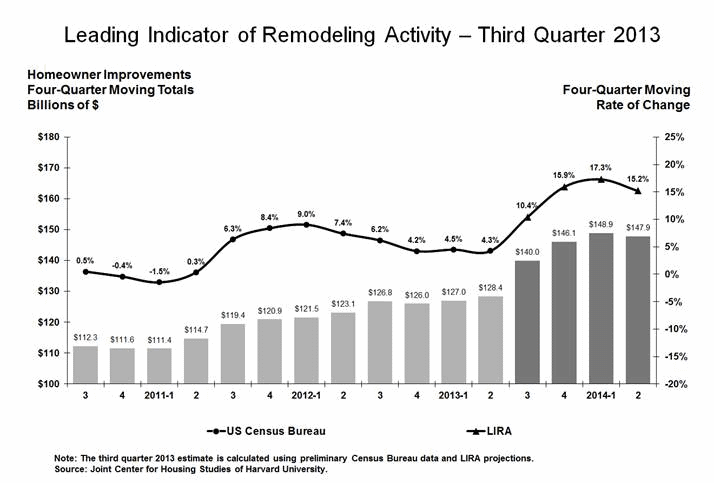LIRA, a forward looking indicator of remodeling activity, continues to project a double digit annual increase in home improvement spending through this quarter and the first quarter of 2014, but cautions it expects a slowdown thereafter. LIRA (Leading Indicator of Remodeling Activity) has projected strong increases since the second quarter of this year, moving from an estimated $128.4 billion in the second quarter to $140.0 billion in the third and $146.1 billion this quarter. As a moving average these increases translate to increases of 10.4 percent in the third quarter and, 15.9 percent in the fourth.
LIRA is a creation of the Joint Center for Housing Studies at Harvard University. It is designed to estimate national homeowner spending on improvements for the current quarter and subsequent three quarters. The indicator, measured as an annual rate-of-change of its components, provides a short-term outlook of homeowner remodeling activity and is intended to help identify future turning points in the business cycle of the home improvement industry.

Looking forward, the projection for spending in the first quarter of 2014 is $148.9 billion, movement of 17.3 percent. Then spending will level off and drop slightly to a projected total of $147.9 billion in the second quarter, a moving average of 15.2 percent.
"The soft patch that homebuilding has seen in recent months, coupled with rising financing costs, is expected to be reflected as slower growth in home improvement spending beginning around the middle of next year," says Eric S. Belsky, managing director of the Joint Center. "However, even with this projected tapering, remodeling activity should remain at healthy levels."
"In the near term, homeowner spending on improvements is expected to see its strongest growth since the height of the housing boom," says Kermit Baker, director of the Remodeling Futures Program at the Joint Center. "Existing home sales are still growing at a double-digit pace, and rising house prices are helping homeowners rebuild equity lost during the housing crash."







